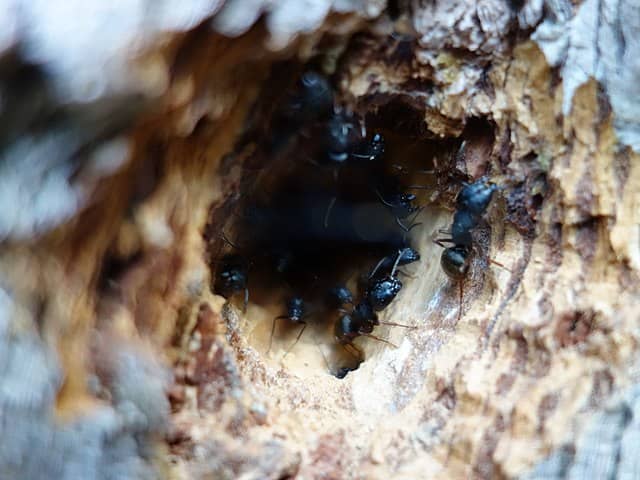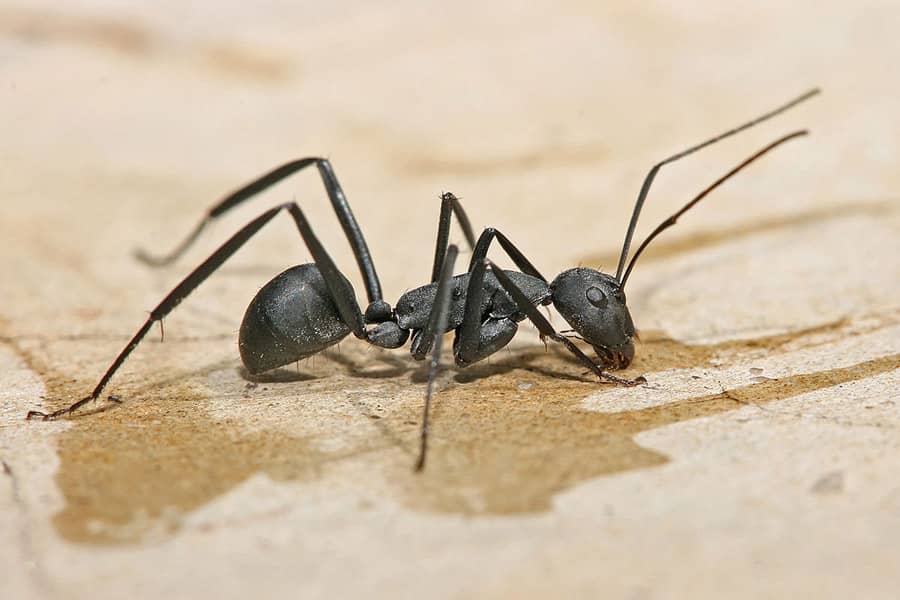What is a Carpenter Ant?
A carpenter ant is a specific type of ant characterized by its nest characteristics. They build their nest through burrowing tunnels inside the wood and create an entire colony in the wood shelter. Carpenter ants, when mature, can have upwards of 10-50,000 individuals in their colony. They usually appear spring through fall as they tend to sit in their nest over the winter period.
The best way to identify a carpenter ant is through body shape and size. They have six legs, can appear red, brown, or black, and are about ½” to ⅝” of an inch. Their thorax is oval with distinct segments and can be found in the US, most commonly in the North. They also might tote a pair of wings, depending on the gender and maturity of the insect.
How do I know I have an Infestation?

There are two main ways to determine if you have an infestation. The first method is actually to identify the ant or swarmers near wood. Use method two if you haven’t made contact with the insect and are still suspicious.
Method two is carefully checking around the wood with a history of moisture issues or fungus. Carpenter ants love to colonize softened wood. After that, look for small openings on the surface of the wood. Suppose there are bits and pieces of insulation, fragments of wood, sawdust-looking debris, or insect body parts that are especially seen underneath one of these holes. In that case, there’s a solid chance that you have a carpenter ant infestation.
It’s always a good idea to contact an exterminator or act immediately after realizing you have a carpenter ant infestation. Following are some DIY solutions and professional solutions to try out.
DIY Solutions

Most DIY solutions aren’t going to be easy, and it will take some time to find the actual nest. However, there will always be multi-stepped solutions, so pick the one that works best for the situation.
It is very important when trying to control a carpenter ant infestation to locate their colony. Once this colony has been located then any properly approved insecticide that is applied directly into the colony can control the ants. Other options include repairing the moisture-damaged wood that the ants have infested in. Eliminate the food, eliminate the ants.
The Pro’s Solution: Step-by-Step Action

Assess the Case
When it comes to an exterminator’s approach, it always comes down to the situation and how quickly we can locate the colony. Carpenter ants are among the most challenging pests to exterminate, even for the pros. It can take multiple treatments to be completely carpenter ant-free. Therefore, it’s always a good idea to find the best exterminator for the job that cares not only about your safety but about what method will fit your lifestyle and situation.
Extermination Methods
There are several methods pest control might take for carpenter ant extermination. Here are a few to note:
Dust Material Treatment:
Used for indoor infestations, an exterminator will use the dust treatment to locate hidden ant colonies in addition to killing the infestation.
Aerosols:
Aerosol insecticides are small particles that can drift around carpenter ant galleries and ultimately make it to the center of the colony to get complete control.
Residual Insecticides:
This insecticide is highly potent and lasts for a LONG time after treatment. This method is usually used for extensive cases that will take more time to treat. The insecticide can be used as a barrier between home and colony, or to kill the carpenter ants inside the colony.
Ant Bait:
Ant baits are not well accepted by carpenter ants and can sometimes take even longer and multiple applications to see control.
Perimeter Treatment:
The perimeter treatment is used in outdoor situations. A treatment is applied to the house’s perimeter or structure to prevent ants from getting to it.
Future Prevention

It is highly recommended to replace all moisture-damaged wood inside and outside the home. Not only does this help with fungal and mold issues, but it also prevents attracting carpenter ants to the interior of your home. Repairing any exterior crevices leading indoors is also helpful. If you ever see a carpenter ant indoors, it’s essential to act quickly!
Conclusion
In the end, acting quickly to find moisture-damaged wood is imperative to help prevent a carpenter ant infestation. Whether on your own or with the help of a professional, carpenter ant extermination is vital for your home’s structural integrity and ease of mind. Rest assured, your home will be creepy-crawly-free at the end of the day once the infestation is handled!

